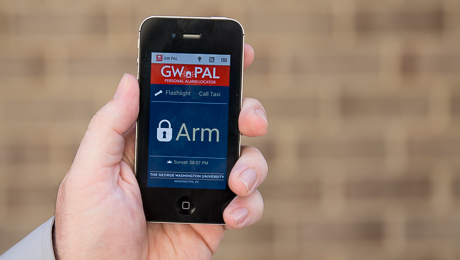By Kristen Mitchell
George Washington University is rolling out an updated version of the smartphone application GW PAL that will enable live tracking and make existing options more efficient.
GW PAL—short for GW Personal Alarm Locator—gives GW students, faculty and staff a direct connection to emergency services. Through the app, users create a profile and can contact emergency services for assistance, call for a safe ride, submit tips to the GW Police Department and receive recent GW Alerts.
The new update enables live tracking, allowing dispatchers to track users as they move through campus. This feature is enabled after users choose to “activate” emergency services on the main interface and press “help.” From there they can describe the nature of an emergency by clicking “police,” “medical” or “fire” before sending geo-tagged alerts to a dispatcher.
The live tracking will be enabled only after users contact emergency services. The update provides dispatchers with automatic location updates every few seconds. The previous version of GW PAL only gave one location update on campus.
“The new live tracking feature will enable emergency personnel to determine if a user has moved since initially activating the app,” Mr. Darnell said. “This will be helpful for emergency personnel attempting to locate a user who may be experiencing a medical emergency and not able to talk.”
If a user activates the app off campus, it connects to 911 instead of GW Police. If a user moves off campus after activating tracking they will be informed tracking has stopped. The app will not send any information to 911.
The app update also prominently displays an option to contact 4Ride, a free service that provides safe rides on and near the Foggy Bottom Campus during late night hours. This replaces the “call taxi” option on the previous version. The flashlight option, now a common built-in application in many smartphones, also has been removed.
Users will still receive recent GW Alerts in the app and have the option to submit security tips and create a user profile with information including current residence and an emergency contact.
The previous version of the app asked users to “arm” the application in the first part of the two-step activation process. This was changed to “activate” for clarity.
GW PAL first launched in August 2014 and was developed by faculty, staff and students in the Office of Safety and Security, the Division of Information Technology and the School of Engineering and Applied Science.
The app is available for free download on iOS and Android devices. Users who already have the app should check to make sure they have received the update.




